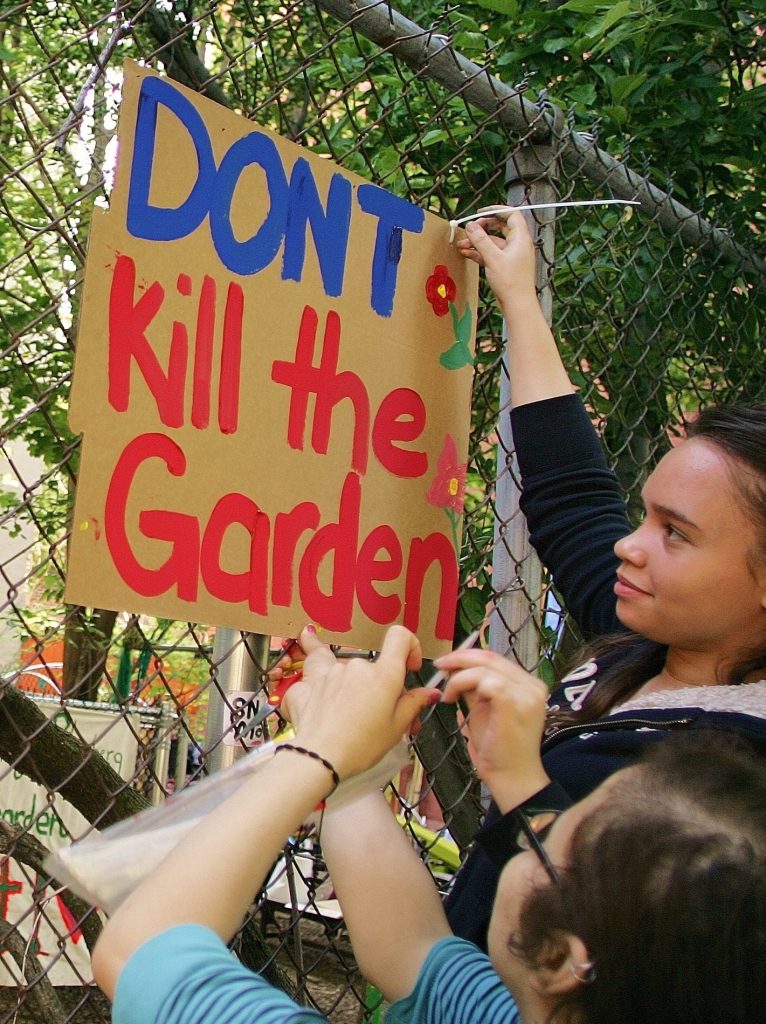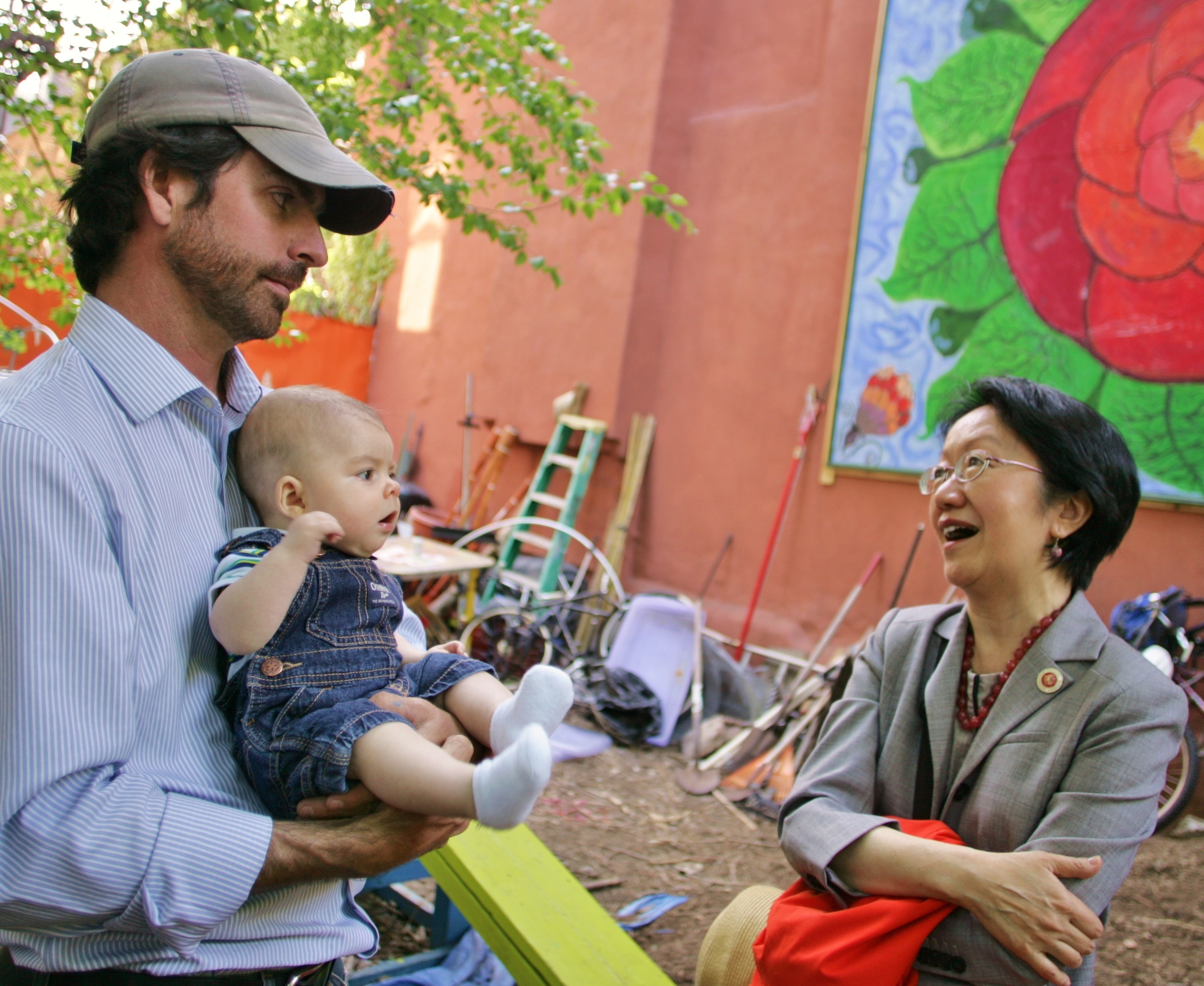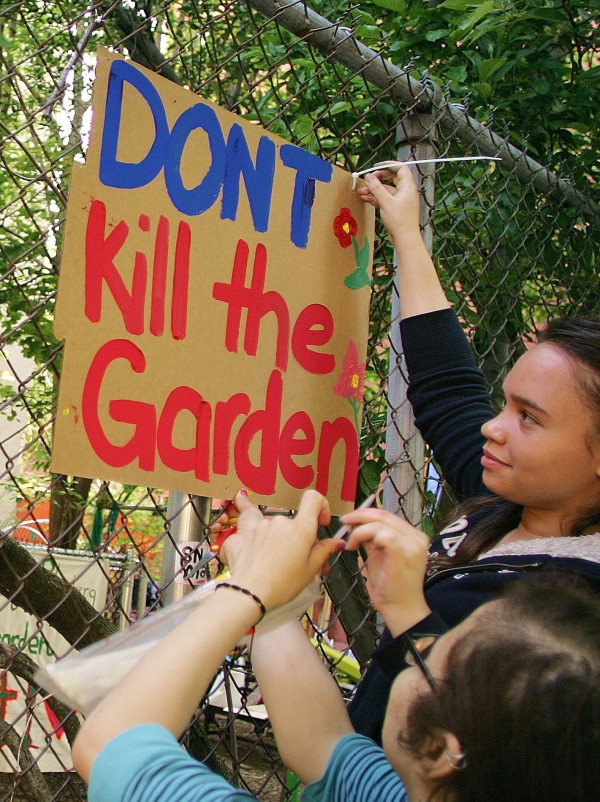
BY SARAH FERGUSON | A week after developer Serge Hoyda drove a fence through the Children’s Magical Garden, gardeners and supporters are working feverishly to restore access to their beloved green oasis on the corner of Norfolk and Stanton Sts.
Hoyda, whose firm S&H Equities owns one of the three lots that make up the garden, claimed he fenced off his portion due to liability concerns.
On Wednesday, gardeners sent the developer a copy of the $2 million insurance policy they took out with the help of Councilmember Margaret Chin to indemnify S&H against any lawsuits that might arise if people were injured on his lot.
“We’re hoping that this will satisfy their concerns so they can remove the fence,” said C.M.G. treasurer Dave Currence, owner of the Tiny’s Giant Sandwich Shop on Rivington St.
Gardeners have also launched an online petition calling on Mayor Bloomberg to make the garden permanent by transferring the garden’s two other lots — which are currently owned by the city’s Department of Housing Preservation and Development — to the Parks Department’s GreenThumb program. The gardeners are further urging the mayor to offer Hoyda a “land swap” whereby he could exchange his relatively small, interior lot for another city-owned parcel elsewhere.
But it seems like Hoyda and his reps may not be in the mood to negotiate — despite being roundly drubbed by the press for their impromptu assault on the garden, which has existed on this corner for the last three decades.
On Tuesday afternoon, gardeners reported that four unidentified men ripped down the colorful posters that children and parents had painted and taped to the fence, calling on Hoyda to “Stop the Serge!” and “Save the Garden!”
A private security guard posted on the corner declined to comment on whether he saw anyone taking down the signs. S&H has maintained round-the-clock surveillance there ever since workers came to fence the lot on the morning of Wed., May 15.
The posters had been put up on the fence enclosing Hoyda’s lot, as well as the outside perimeter fence, which was erected by C.M.G. gardeners decades ago in their effort to rid the lots of junkies.
“Why would someone fight with the children? The children made these posters,” asked a student from Marte Valle High School who posted a video of the incident on the garden’s Facebook page.
It’s not known whether the men who took down the posters were acting on behalf of anyone affiliated with S&H Equities. Hoyda, representatives of S&H, and Rex Whitehorn, the attorney on site when the fence was erected, did not respond to numerous calls and e-mails requesting comment on the fencing of the lot and their plans for the site. When The Villager reached Rosalie Schwartz, the contact listed on the fence permit filed with the city’s Department of Buildings, she slammed down the phone.
But according to city officials, Hoyda is still seeking to partner with H.P.D. to develop the whole garden site as a mix of market-rate and affordable housing.
H.P.D. officials say the developer contacted the agency on Monday to reaffirm his interest in pursuing the “mixed-use” proposal, which Hoyda/S&H had first pitched to the city back in 2006.
H.P.D. says its lots are “reserved” for future affordable housing, but it has not committed to any plan for development.
“At this point the proposal [from S&H] is still in a very preliminary state and there hasn’t been a decision regarding whether or not to move forward,” H.P.D. spokesperson Eric Bederman told The Villager on Wednesday, adding, “We are still working closely with Councilmember Chin and her staff to assess available options with relation to these sites.”
Chin said she is reaching out to H.P.D. and the Parks Department in hopes of preserving all of the Children’s Magical Garden at its present location.
“The garden is a treasure, so we have to fight to keep it in the community,” Chin said, adding, “By putting up a fence, he [Hoyda] is not being a good neighbor and he’s not helping his case.”
This is not the first time C.M.G. gardeners have faced down threats from Hoyda, the developer behind the long-stalled Hotel Ludlow, a 20-story boutique hotel still under construction, which he recently sold for $25 million, as well as numerous other properties on the Lower East Side.
Gardeners staked their claim to the lots 30 years ago, using baseball bats to chase out junkies as they began clearing what where then rubble-strewn plots festering with rats and garbage.
They put up their own fence and began planting peach trees and tomatoes and organizing after-school programs for local children. But they were never offered a Greenthumb lease, in large part because a portion of the land was privately owned.
The garden first came under threat in 2000, when Hoyda, who had been acquiring properties on the Lower East Side, signed a contract to purchase the lot from the prior owner. Gardeners say Hoyda’s workers knocked down the small casita (shack) in the lot, chopped down a Christmas tree, and erected a fence, which the gardeners immediately tore down. (S&H could not be reached for comment on these allegations.)
According to city property records, Hoyda purchased the lot in 2003 for $180,000. He first floated the idea of building luxury condos on the site, then offered to partner with H.P.D. to build a mix of affordable and market-rate housing.
In October 2006, Community Board 3 voted to reject that proposal, and instead urged S&H and H.P.D. to work with the gardeners and greening groups to “explore other possible proposals” for the land.
At the time, city officials were urging the gardeners to relocate to another vacant lot a few blocks east on Attorney St. But the C.M.G. members declined, and that lot is now tended by another garden group, Siempre Verde.
Children’s Magical Garden went through its own ups and downs over the years, particularly after the death of its co-founder Carmen Rubio in 2005 and the subsequent departure of her partner Alfredo Feliciano, who had been the primary caretaker for the site. But three years ago, the garden group revived under new leadership of longtime member Kate Temple-West and Aresh Javadi of the activist group More Gardens! Working with a pro-bono attorney, they formed a nonprofit with other local residents to create a formal structure to run the garden. Last fall, the new C.M.G. board reached out to Hoyda in hopes of getting him to either donate his lot or work out some kind of land swap with H.P.D.

“We were trying to be proactive and to work with the owner to protect the garden,” said Javadi, who has campaigned to preserve green spaces throughout the city.
But Javadi said they did not hear back from Hoyda until March, when the developer told them he would be erecting a fence. Javadi then contacted Councilmember Chin, who sought to intervene and offered to help put Hoyda’s representative in touch with H.P.D. to discuss Javadi’s idea of a land swap.
Chin staffer Matthew Viggiano said he reached out to H.P.D. Assistant Commisisoner Christopher Gonzalez, and assumed that discussions were underway.
“We knew that H.P.D. had reached out, so we thought those conversations were ongoing,” said Viggiano.
H.P.D. officials, however, say they last spoke to the Hoyda’s reps in February — before the threat of a fence ever came up. They say the notion of a “land swap” was never discussed. Swapping city property for privately owned land is “not a common practice,” said Bederman, and would require approval by the City Council and Mayor’s Office.
But while Hoyda has struggled to find a development foothold on the site, the gardeners have extended their roots into the community. C.M.G. now serves as an outdoor classroom for four neighboring schools, including Lower East Side Prep’s E.S.L. class, Marta Valle High School, which offers culinary classes, and School for Global Leaders, which has run community outreach programs out of the garden for the past three years.
Grand Street Settlement runs spring and summer programs for its Head Start program there, and the Cub Scouts are regular visitors.
This spring, parents from the Anna Silver School (P.S. 20) on Essex St. were planning to partner with C.M.G. to grow herbs as part of the “Wellness in the Schools” (WITS) program for promoting healthy eating.
But that hope was dashed when Hoyda’s workers cemented fence posts through the center of their freshly tilled beds.
“They just tore right through that herb garden, which is one of the only places where we can grow herbs,” complained Emily Commer, whose 5-year-old son Tristan attends P.S. 20. “We were working to get the school chefs to come pick herbs with the kids and use them in cooking classes. Now we can’t even get at our plants.”
Chin, who hung out to watch kids painting banners and signs in the garden last Thursday, thinks the city would be shortsighted to overlook the role that C.M.G. now plays on the Lower East Side.
“Affordable housing is important in our community, but we also have to look at the history of this garden. I mean it’s been here 31 years,” she noted. “When you look around this area, there is not much open space.”
Chin pointed out that the city will be building many more units of affordable housing on the Seward Park Urban Renewal Area site south of Delancey St., attracting more children in need of green space.
“Just as easy as that fence went up, the fence can come down,” Chin said. She questions what Hoyda can build on his small interior lot (roughly 26 feet by 73 feet) without partnering with H.P.D. to develop its lots too. “Maybe he can build a birdhouse that overlooks the garden,” she remarked.
Ironically, though he’s been played by the media as a villain in this case, on his Web site, Hoyda paints himself as a philanthropist for children’s causes. He sits on the boards of the Jewish Children’s Museum in Brooklyn and the Save a Child’s Heart Foundation, an Israeli group that provides heart surgeries to children from developing countries.
But the kids at C.M.G. say that Hoyda needs to show them some heart, too.
“That garden represents my childhood, all my memories. It will leave a scar if it’s gone,” said Amina Begum, an 18-year-old senior at Marte Valle High School who has been coming to C.M.G. since the sixth grade.
“It’s like we can’t be on our own land,” added Begum, who still hangs out in the garden nearly every day, and even wrote about its role in her life for her college entrance essay to the New School. “We had this meditation [plant] bed that we were working on, and now we can’t take care of it because the fence is there. And our wishing tree — that mulberry tree — where we tied ribbons with wishes on them. … Our plants are going to die if we can’t water them.”
Wilma Alvarez, who lives in the tenement next door to C.M.G., said her grown children —now 22 and 23 years old — helped create the garden.
“This place was a dump, full of old furniture, needles, everything,” she said. “My kids helped clear it out and started planting seeds. We did this so we could have a safe place away from the druggies.
“This was done by the community for the kids,” she said. “I feel it should stay with the kids. It should be here for every generation.”
The Children’s Magical Garden is on the agenda of the Thurs., June 13, meeting of Community Board 3’s Parks Committee. Representatives from the garden and the developer have been invited to appear.


















